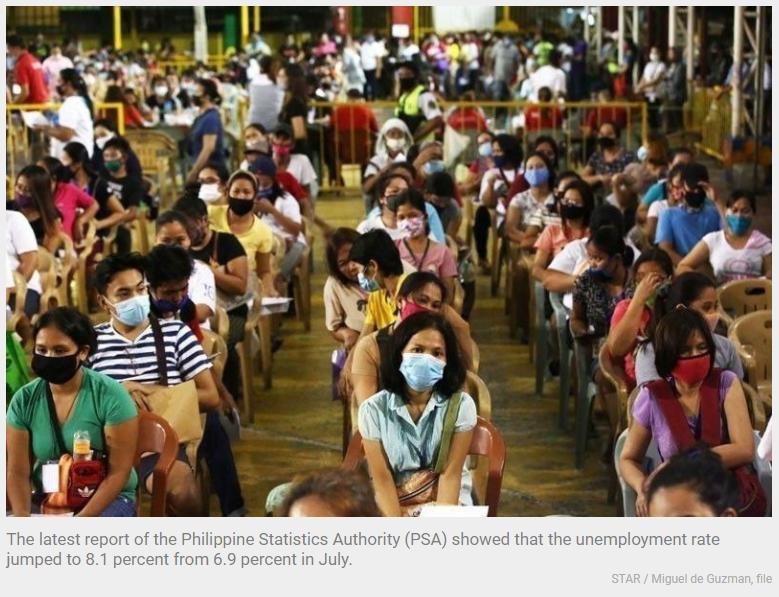Philippines: Unemployment worsens with 3.9 million jobless Pinoys
MANILA, Philippines — The country’s labor situation deteriorated anew in August as the number of jobless Filipinos rose following the fresh round of lockdowns due to a spike in COVID cases.
The latest report of the Philippine Statistics Authority (PSA) showed that the unemployment rate jumped to 8.1 percent from 6.9 percent in July.
This accounts for 3.88 million unemployed Filipinos in the labor force. In August alone, some 800,000 individuals went jobless.
The government reimposed for the third time in August the strictest community quarantine in Metro Manila, nearby economic hubs and other provinces due to surging virus cases amid the spread of the more transmissible Delta variant.
President Duterte’s economic team said the spike in the jobless rate was expected with the return to lockdown during the month.
With the possibility of further easing restrictions as COVID cases start to decline and more Filipinos get vaccinated, economic managers maintained that the trend would aid in recovery.
“This trend will support the further reopening of the economy and the use of granular lockdowns to allow the majority to return to work and earn a living,” they said.
But Leonardo Lanzona, labor economist and professor at the Ateneo de Manila University, said the prospects for a quick recovery seems out of the question even without the lockdowns.
“Once we ease the alert levels, we can experience gains mainly because of base effects. But after that, the road remains difficult,” Lanzona told The STAR.
He said a comprehensive industrial plan that includes retraining and education would be needed.
More than the weak pandemic response in testing and vaccination, Lanzona maintained that the government should start exploring how industries can be developed in other areas.
Economic activities are highly concentrated in Metro Manila, Calabarzon and Central Luzon. Paralyzing the three regions thus results in severe economic repercussions, including job and income losses.
“The goal is to create more urban areas in the country that can foster more industrialization. We can hedge risks by strategically using government funds to offset the risks of any market disruption,” Lanzona said.
IBON executive director Sonny Africa, for his part, said the government’s job creation strategy has to be drastically overhauled to address the structural problem of widespread informality made even worse by the pandemic.
Africa said long-term sustainable job creation can only come from a more robust agriculture and Filipino industry, while proper containment of the pandemic instead of lockdowns can save jobs in the short term.
“And the best way to immediately restore so much lost jobs and collapsed livelihoods is by giving substantial ayuda, which will spur domestic demand and give community entrepreneurs and small enterprises a reason to stay in business,” Africa told The STAR.
“Meaningful ayuda and ample support for small enterprises will create a virtuous cycle of demand, growth and investment,” he said.
Meanwhile, the country’s labor force participation rate, or those Filipinos aged 15 years and above, improved to 63.6 percent of the total working age population from 59.8 percent, as more people rejoined the labor force.
This is equivalent to around 48.12 million economically active Filipinos whether employed or looking for work, a significant increase from the 44.74 million in July.
The underemployment rate, pertaining to the proportion of workers who were looking for more hours of work, also eased to 14.7 percent or 6.48 million Filipinos from 20.9 percent or 8.69 million the previous month.
With restrictions in place during the month, the average weekly hours of work of an employed person decreased to 39.6 hours from 41.8 hours in July.
The economic team said safe reopening of the economy, limiting restrictions to granular lockdowns, and accelerating the vaccination program are key to the recovery.
They are also banking on the delivery of more than 125 million doses by the end-2021 and the opening of vaccination to the general population by October.
The economic team said the government will continue pursuing structural reforms to provide the country with a strong foundation for growth beyond the pandemic as it called on lawmakers to swiftly pass needed legislation.
These include amendments to the Public Service Act, Retail Trade Liberalization Act, and Foreign Investment Act, to help the country attract more foreign investments and build better infrastructure.
Meanwhile, the industries that showed the largest decrease in job creation include education at 238,000, administrative and support service activities at 183,000, and professional, scientific and technical activities at 110,000.
The economic managers said jobs in education are expected to improve gradually following Duterte’s approval to begin piloting face-to-face classes in low-risk areas.
Increases, on the other hand, were recorded in agriculture and forestry, wholesale and retail trade, and manufacturing.
Workers are grouped into the three sectors, namely, agriculture, industry, and the services sector. Those in the services sector comprised most of the employed persons, accounting for 56 percent share during the month.
Services sector was followed by agriculture with 25.1 percent share while the industry sector accounted for the smallest share of 18.9 percent.
Source: https://www.philstar.com/business/2021/10/01/2130868/unemployment-worsens-39-million-jobless-pinoys


 English
English




